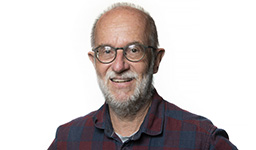Martin Schlabach

Medlem av faggruppen for forurensinger, naturlige toksiner og medisinrester
Forurensninger, naturlige toksiner og medisinrester
Martin har doktorgrad i fysikalsk kjemi. Hans nøkkelkompetanse innenfor VKMs fagområder er forekomst og miljøskjebne av nye miljøgifter.
Stilling
Pensjonist
Utdanning
1985: diplom chemie, Albert-Ludwigs-Universität, Freiburg, Tyskland
1989: Pdh, Albert-Ludwigs-Universität, Freiburg, Tyskland
Arbeidserfaring
2005 - 2022: seniorforsker/avdelingsleder, avdeling for miljøkjemi, NILU, Norge
1995 - 2005: Seniorforsker, avdeling for miljøkjemi, NILU, Norge
1989 - 1995: Forsker, avdeling for miljøkjemi, NILU, Norge
1984 - 1989: Forsker, Institute of Physical Chemistry,Universitetet i Freiburg, Tyskland
Øvrig faglig bakgrunn
PROJECT MANAGEMENT EXPERIENCE:
2010 - 2022: Norwegian Screening Studies/Compounds of Emerging Concern/Project leader/Norwegian Environmental Agency
2000 - 2022: Strategic Institute Program/Compounds of emerging concern/Project leader/NILU’s base funding
2019 - 2020: Nordic Screening Study/Compounds of emerging concern/Project leader/NMR
EXPERIENCE FROM RELEVANT RESEARCH & INNOVATION ACTIVITIES:
2000 - 2022: Several projects/Developments of analytical methods (target methods) for many different compounds of emerging concern/project leader, supervision of students and other scientists/funding form RCN and Norwegian Environmental Agency
2008 - 2022: Strategic institute program/Innovation and development of non-target screening methods for compounds of emerging concern/project leader, supervision of students and other scientists/NILU’s base grant
2017 - 2019: SkiFT Innovation project/Idea and concept development, implementation and field testing of a measurement device for fluorinated ski waxes used in cross country competitions (SkiFT)/Project leader and scientific developer/NILU’s basic grant and Norwegian Ski Association
EXPERIENCE FROM NATIONAL/INTERNATIONAL COLLABORATION/NETWORKING:
2014 - 2020: NORMAN (Network of reference laboratories, research centres and related organisations for monitoring of emerging environmental substances)/Member of the Steering Committee/Coordination of the development of new analytical tools and techniques for the monitoring of compounds of emerging pollutants/more than 100 member institutes from Europe, America and Asia
2011 - 2020: Norwegian Environmental Specimen Bank (a national infrastructure owned of KLD/1. Main scientific advisor during design and building of the bank’s infrastructure, 2. Scientific advisor during design and planning of the bank’s sampling program, 3. Member of the expert group of the Environmental Specimen Bank
2010 - 2020: Norwegian Screening Studies for the measurement of Compounds of Emerging Concern/Project leader and analytical scientist designing sampling program and developing relevant analytical methods/Collaboration with NIVA, NPI, and Akvaplan niva on sampling and analysis and collaboration with the employer (Norwegian Environmental Agency) on Sampling strategy
OTHER RELEVANT MERITS:
Supervision of graduate students and research fellows
2010-2020: 2 Postdocs/4 PhD/4 Master/10 Bachelor Students
Utvalgte publikasjoner
Röhler, L., et al., Non-target and suspect characterisation of organic contaminants in ambient air – Part 1: Combining a novel sample clean-up method with comprehensive two-dimensional gas chromatography. Atmos. Chem. Phys., 2021. 21(3): p. 1697-1716.
Röhler, L., et al., Non-target and suspect characterisation of organic contaminants in Arctic air – Part 2: Application of a new tool for identification and prioritisation of chemicals of emerging Arctic concern in air. Atmos. Chem. Phys., 2020. 20(14): p. 9031-9049.
Dulio, V., et al., The NORMAN Association and the European Partnership for Chemicals Risk Assessment (PARC): let's cooperate! Environmental Sciences Europe, 2020. 32(1): p. 11.
Sakhi, A.K., et al., Concentrations of selected chemicals in indoor air from Norwegian homes and schools. Science of The Total Environment, 2019. 674: p. 1-8.
Hollender, J., et al., High resolution mass spectrometry-based non-target screening can support regulatory environmental monitoring and chemicals management. Environmental Sciences Europe, 2019. 31: p. 11.